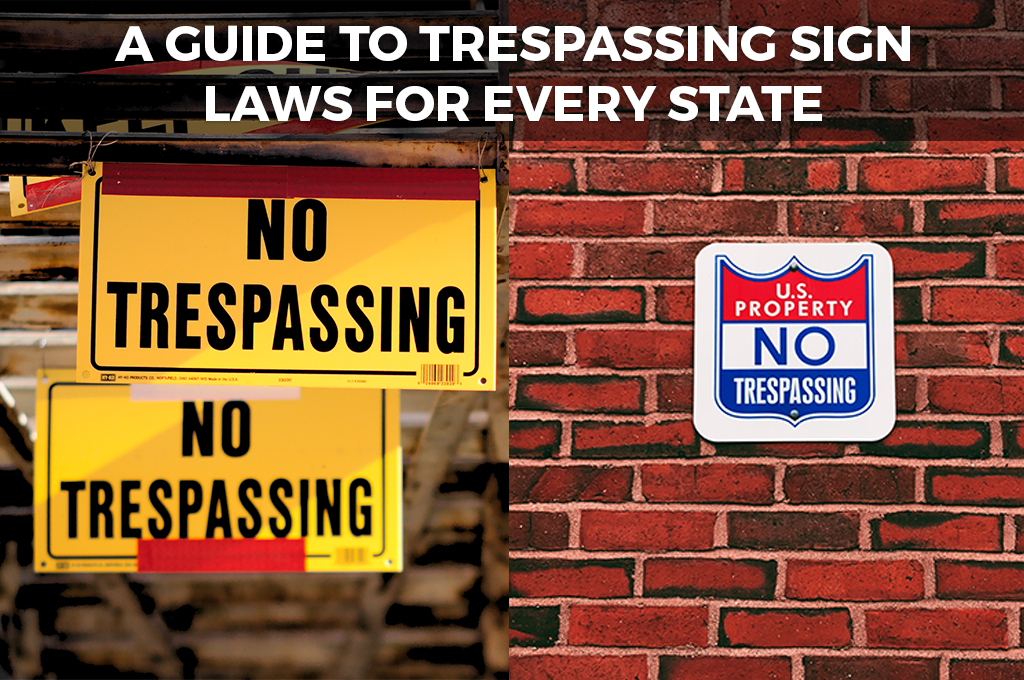For landowners, the nuisance of potential trespassers and the liability that comes with them is a real concern. Because of this issue, many owners of private land must take special care to post the appropriate signage to deter passersby or people with nefarious intentions from going in.
A formal “no trespassing” sign may differ in format and content from state to state since trespassing laws vary across the country, but all states have them in some form or another.
But what is trespassing, exactly? Generally speaking, criminal trespassing is defined as “entering or remaining on another’s property without the owner’s consent”, but each state has its own specification as well. The consequences for this crime also vary from state to state but may include fines or jail time. However, the penalty may be more severe if significant damage is done to the property.
“No Trespassing” Sign Guidelines By State
Property owners have greater legal recourse if they have properly written notices posted. Below we break down the trespassing laws and notice/signage requirements for all 50 states as a guideline when creating your property’s signage.
While most states do not have specific guidelines on the sign text itself, it can be a good idea to familiarize yourself with the appropriate statute that can be listed at the bottom of your sign for reference, should you want to include it in the notice.
Legal Disclaimer: The following information is not official legal advice, and any laws listed may be subject to change. For official legal counsel on property concerns, consult an attorney or another legal professional.

Alabama
According to Alabama law, “A person is guilty of criminal trespass in the third degree when he knowingly enters or remains unlawfully in or upon premises.”
No trespassing signs in Alabama must be reasonably likely to come to the attention of intruders and should provide a reference to the legal code Title 13A. Criminal Code § 13A-7-4.
Alaska
In Alaska’s trespassing statute, AS 11.46.350, notice against trespassing must be either personally communicated or given by posting “in a reasonably conspicuous manner under the circumstances.”
Notices should be placed at all access points to the property, be legible in English, and contain specific prohibitions such as no trespassing, digging, hunting, etc.
Arizona
Arizona’s trespassing law, A.R.S. §13-1502, states that property owners must provide a reasonable notice prohibiting entry.
Arkansas
Arkansas statute Ark. Code Ann. § 5-39-203 states that criminal trespassing occurs when a “person unlawfully enters either someone’s property or vehicle.”
Violations of this statute are a Class C misdemeanor unless the land is clearly marked with a “No Trespassing” or “Keep Out” sign.
California
California Penal Code Section 602 PC includes over thirty different forms of trespassing, but all adhere to the same general elements of willfully entering or remaining on someone else’s property.
Landowners should have either “No Trespassing” signs posted, and/or enclose their land with a fence.
Colorado
The law in Colorado is fairly strict regarding trespassing, and may even be considered a felony if criminal intent is involved. Colo. Rev. Stat. § 18-4-504 considers it criminal trespassing if a person “unlawfully enters or remains in or upon premises of another.”
No trespassing notices may include the statute citation at the bottom.
Connecticut
Under Conn. Gen. Stat. § 53a-110a, a first-degree criminal trespass occurs when a “person enters or remains in a building or any other premises after an order to leave or not to enter personally communicated to such person by the owner of the premises or another authorized person.”
Delaware
11 Del. Code § 821 explains that a person may be found guilty of trespassing when he or she “knowingly enters or remains unlawfully upon real property.”
Florida
In Florida, Fla. Stat. § 810.09 defines trespassing as “A person who, without being authorized, licensed, or invited, willfully enters upon or remains in any property other than a structure or conveyance.”
Florida’s laws state that notices against entering or remaining should be communicated by posting, fencing, or cultivation, as explained in Florida statute 810.011. This statute offers several requirements for signage, among them:
- Letters no less than 2 inches in height, with the words “No Trespassing” and the name of the owner of the land
- Placed no more than 500 feet apart on agricultural land in a clearly noticeable place
- The bottom of the sign should not be less than three feet or more than five feet from the ground
Georgia
In Georgia trespassing law, O.C.G.A. § 16-7-21 defines trespassing as a person who “intentionally damages any property of another without consent of that other person and the damage thereto is $500.00 or less or knowingly and maliciously interferes with the possession or use of the property of another person without the consent of that person.”
Hawaii
Under Haw. Rev. Stat. § 708-814, it is considered trespassing when a “person knowingly enters or remains unlawfully in or upon premises.”
Property owners should post sign(s) that say “Private Property –– No Trespassing”, with lettering no less than two inches in height, placed at reasonable intervals along the boundary of the land as well as all entrances to the property.
Idaho
In Idaho, I.C. § 18-701 states that trespassing is “when he enters or remains on the real property of another without permission, knowing or with reason to know that his presence is not permitted.”
No Trespassing signs in Idaho should include bright orange or fluorescent paint, “at all property corners and boundaries where the property intersects navigable streams, roads, gates and rights-of-way entering the land”, so that a reasonable person would be put on notice that it is private land.
Illinois
Illinois’ 720 ILCS 5/21-3 statute, there are three incidents of criminal trespass: real property, residence, and vehicles.
A printed or written notice forbidding entry should be posted at the main entrance to the land or forbidden area, as well as purple paint, which signifies notice in Illinois.
Indiana
Indiana Code § 35-43-2 states that a person is trespassing when he or she “knowingly or intentionally enters the real property of another person after having been denied entry by the other person or that person’s agent.”
While Indiana permits signage posting for “No Trespassing”, like Illinois, you can also use purple paint to give notice. The markings must be visible, starting at least three inches off the ground and covering the top two inches of the post.
Iowa
Under Iowa Code § 716.8, “Any person who knowingly trespasses upon the property of another commits a simple misdemeanor.” However, the intent of the trespasser is also taken into consideration and may alter the degree of a misdemeanor.
Kansas
The state trespassing law in Kansas, Kan. Stat. Ann. § 21-5808 states that trespassing is “entering or remaining upon or in” public or private land that someone does not have authorization or permission to access.
Signs, postings, and purple paint are all considered notices of private property in Kansas.
Kentucky
Under Ky. Rev. Stat. § 511.080, “A person is guilty of criminal trespass in the third degree when he knowingly enters or remains unlawfully in or upon premises.”
Louisiana
The La. Rev. Stat. Ann. § 14:63 statute states that “No person shall enter any structure, watercraft, or movable owned by another without the express, legal, or implied authorization.”
It goes on to explain that persons forbidden from entering the property must be expressly informed either verbally or in writing.
Maine
In Title 17-A, §402 section of the Maine criminal code, it explains that “A person is guilty of criminal trespass if, knowing that that person is not licensed or privileged to do so, that person” enters any dwelling place, locked or barred structure, or any place that he or she is lawfully excluded, among other specific instances.
Under Rule 303 in the Maine Rules of Evidence, a posted sign or paint marking must be placed in a “manner reasonably likely to come to the attention of intruders.”
Maine law offers some specific guidelines for no trespassing signage, stating that signs must:
- Indicated that access is prohibited without the permission of the landowner or landowner’s agentMark the property at intervals of no greater than 100 feet and at all vehicular access points from a public road
The use of paint markings must consist of a vertical line at least one inch wide and eight inches in length, no less than three feet from the ground and more than five feet off the ground.
Maryland
Md. Code, Crim. Law § 6-402 states that “ person may not enter or trespass on the property that is posted conspicuously against trespass”, specifying that signs must be placed where they can reasonably be seen, or paint marks must conform with regulations of the Department of Natural Resources.
Paint marks must be placed on trees located at each road entrance to the property, as well as those adjacent to public spaces.
Massachusetts
In Massachusetts, M.G.L. c. 266, § 120 states that trespassing occurs when “Whoever, without right, enters or remains in or upon the dwelling house, buildings, boats or improved or enclosed land, wharf, or pier of another, or enters or remains in a school bus … after having been forbidden so to do by the person who has lawful control of said premises, whether directly or by notice posted thereon…”
A formal notice must be communicated by posting of a “no trespassing” sign on the property or direct notification.
Michigan
Under Mich. Comp. Laws § 750.552, a person may not “Enter the lands or premises of another without lawful authority after having been forbidden to do so by the owner or occupant or the agent of the owner or occupant.”
At any point of entry upon the property, there must be not less than one sign. Minimum letter height on the posting signs is one inch, and each posting sign should not be less than fifty square inches.
Minnesota
Minnesota statute 609.605 says that a person is guilty of a misdemeanor if he or she intentionally “trespasses on the premises of another and, without the claim of right, refuses to depart from the premises on demand of the lawful possessor.”
Posted “no trespassing” signs must be at least 8 ½ by 11 inches in a conspicuous place on the exterior of the building or within the property in which the building is located. The sign must carry a general warning against trespassing.
Mississippi
The trespassing law in Mississippi, defined in Mississippi Code Title 97. Crimes § 97-17-93, states that trespassing occurs when “Any person who knowingly enters the lands of another without the permission of or without being accompanied by the landowner or the lessee of the land, or the agent of such landowner or lessee…”
While landowners are not required to post any trespassing signs on their property, it is recommended, as they have more legal recourse in the event of a trespassing incident.
Missouri
Missouri statute Mo. Rev. Stat. § 569.140, says that trespassing occurs when “property is fenced or otherwise enclosed in a manner designed to exclude intruders or as to which notice against trespass is given…”
The notice must be given through actual communication to the actor or posting in a manner that is reasonably likely to come to the attention of intruders.
Montana
MCA § 45-6-203 defines trespassing as when “A person enters or remains unlawfully in or upon any vehicle, occupied structure, or premises when the person is not licensed, invited, or otherwise privileged to do so.”
To meet the requirements for posting on private land, the notice must:
- Be placed on a post, structure, or natural object with at least 50 square inches of fluorescent orange paint
- Appear on outer gates and normal points of access
Nebraska
Nebraska’s laws against trespassing, as listed in Neb. Rev. Stat. § 28-521 state that a person commits trespassing in the second degree if “knowing that he or she is not licensed or privileged to do so, he or she enters or remains in any place as to which notice against trespass is given…”
Communication to the actor must be given verbally or posted in a manner reasonably likely to come to the attention of intruders.
Nevada
In Nevada, it is considered trespassing when one “Willfully goes or remains upon any land or in any building after having been warned by the owner or occupant thereof not to trespass,” according to NRS 207.200.
Depending on the type of land, owners can indicate no trespassing areas through painting a post an orange fluorescent color, at intervals of not more than 200 feet.
New Hampshire
New Hampshire’s law against trespassing, NH RSA § 635:2, states that “A person is guilty of criminal trespass if, knowing that he is not licensed or privileged to do so, he enters or remains in any place.”
Notices to prohibit criminal trespass must be posted on durable signs with words describing the prohibited activity, such as “No Hunting or Trespassing”, written in block letters no less than two inches tall, and include the name and address of the landowner or lessee. These signs should be posted no more than 100 yards apart.
New Jersey
New Jersey law, as described in NJ Rev Stat § 2C:18-3 defines a defiant trespasser as “A person … knowing that he is not licensed or privileged to do so, he enters or remains in any place as to which notice against trespass is given.”
This notice/communication must be given through actual communication to the actor or posting in a manner reasonably likely to come to the attention of intruders.
New Mexico
The New Mexico Statute Section 30-14-1 states that criminal trespass “consists of knowingly entering or remaining upon posted private property without possessing written permission from the owner or person in control of the land.”
Notices in New Mexico must be:
- Printed legibly in English
- At least 144 square inches in size
- Contain the name and address of the property’s person of authority
- Placed at each roadway or apparent way of access to the property
- State-specific prohibitions such as “No Trespassing”, “No Hunting,” etc.
New York
New York penal code Article S 140.05 defines trespassing as when someone “knowingly enters or remains unlawfully in or upon premises.”
The no trespassing notice must be given in a posting in a conspicuous manner.
North Carolina
In North Carolina, according to statute § 14-159.13, one commits trespassing when “without authorization, he enters or remains on premises of another.”
Notices against trespassing must be posted in a conspicuous place an intruder would be reasonably likely to encounter.
North Dakota
In North Dakota, NDCC § 12.1-22-03 is the state trespassing law, stating that an individual is guilty of criminal trespass if “knowing that that individual is not licensed or privileged to do so, the individual enters or remains in a dwelling or in highly secured premises.”
Sign requirements for North Dakota include:
- Likely to come to the attention of intruders
- Name of the person posting the premises in legible characters
Ohio
According to the Ohio Rev. Code § 2911.21, criminal trespassing is considered when someone “knowingly entersor remains on the land or premises of another.”
No trespassing postings in Ohio must be done “in a manner reasonably calculated to come to the attention of potential intruders, or by fencing or other enclosure manifestly designed to restrict access.”
Oklahoma
Oklahoma statute §21-1835 defines the act of trespassing as “ Whoever shall willfully or maliciously enter the garden, yard, pasture or field of another after being expressly forbidden to do so or without permission by the owner or lawful occupant thereof when such property is posted…”
Signs in Oklahoma must be posted in block letters with specific prohibited activities or notices listed, such as “PROPERTY RESTRICTED”; “POSTED – KEEP OUT”; “KEEP OUT”; “NO TRESPASSING”, or the like. They must also be placed conspicuously at places where entry to the property is normally expected.
Oregon
The Oregon Statute 2017 ORS 105.700 states that trespassing has occurred if someone “entered and remained upon the land of the plaintiff without the permission of the plaintiff.”
No trespassing signs in Oregon must be:
- no smaller than eight inches in height and 11 inches in width
- contain the words “Closed to Entry” or words to that effect in letters no less than one inch in height
- display the name, business address, and phone number, if any, of the landowner or agent of the landowner
Pennsylvania
Pennsylvania’s criminal trespass law 18 Pa.C.S. § 3503 states that a defiant trespasser is someone who, “knowing that he is not licensed or privileged to do so, he enters or remains in any place as to which notice against trespass is given…”
No trespassing signs in Pennsylvania must be posted in a conspicuous manner likely to be noticed by an intruder.
Rhode Island
In Rhode Island, the criminal code § 11-44-30 states that signs indicating no trespassing must be:
- Posted conspicuously
- Printed legibly
- Affixed with cloth, metal, or paperboard
South Carolina
According to South Carolina’s no trespassing statute, S.C. Code §16-11-620 is defined as unauthorized entry into the land or building of another.
Signs in South Carolina must be posted in a conspicuous manner.
South Dakota
In South Dakota, SDLRC – Codified Law 22-35-6 trespassing occurs when “any person who, knowing that he or she is not privileged to do so, enters or remains in any place where notice against trespass is given…”
Postings in South Dakota must be reasonably likely to come to the attention of trespassers and/or fencing or enclosure that a reasonable person would recognize as being designed to prevent trespassing.
Tennessee
Tennessee Code 39-14-405 defines criminal trespass as when an individual “enters or remains the property, or any portion of the property, without the consent of the owner.”
Signs in Tennessee should be printed legibly, posted at least three feet from the ground, and contain designations of the prohibited activities.
Texas
Texas Penal Code – PENAL § 30.05 states that a person commits a trespassing offense “if the person enters or remains on or in property of another, including residential land, agricultural land, a recreational vehicle park, a building, or an aircraft or another vehicle, without effective consent…”
Notices and postings in Texas should:
- Indicate that entry is forbidden
- Be posted at all entrances
- Be reasonably likely to come to the attention of intruders
Utah
Utah’s criminal trespass law, 76-6-206 explains that anyone who enters and remains on property which notice prohibiting entry is given is guilty of criminal trespassing.
Posted signs in Utah should be posted in areas reasonably expected to be seen by intruders.
Vermont
Statute 13 V.S.A. § 3705 states that unlawful trespassing occurs when an individual “enters or remains on any land or in any place as to which notice against trespass is given.
Any signs or placards must be “designed and situated as to give reasonable notice.”
Virginia
As defined in the Code of Virginia, “any person without the authority of law goes upon or remains upon the lands, buildings or premises of another, or any portion or area thereof, after having been forbidden to do so…” commits trespassing.
No trespassing signs in Virginia must be posted “on such lands, structures, premises or portion or area thereof at a place or places where it or they may be reasonably seen…”
Washington
Washington Revised Code § 9A.52.070 states that “A person is guilty of criminal trespass in the first degree if he or she knowingly enters or remains unlawfully in a building.”
Signs in Washington must be conspicuously posted.
West Virginia
West Virginia Code §61-3B-3 defines trespassing as “willful unauthorized entry upon, in or under the property of another…”
Signs in West Virginia must be:
- Posted at all roads, or gates of entry into the land
- Reasonably conspicuous
Wisconsin
According to the Wisconsin Code Chapter 943, trespassing occurs when someone “Enters or remains on any land of another after having been notified by the owner or occupant not to enter or remain on the premises.”
No trespassing signs in Wisconsin must:
- Include the name of the owner of the land
- Be at least five by seven inches in size
Wyoming
WY Stat § 6-3-303 states that a person is guilty of criminal trespass if “he enters or remains on or in the land or premises of another person, knowing he is not authorized to do so, or after being notified to depart or to not trespass.”
Posted signs in Wyoming should be posted in areas reasonably expected to be seen by intruders.
Cover Your Bases with No Trespassing Signs
No matter where you live if you are a landowner, you want to make sure you are taking all the steps necessary to protect your property from trespassers.
Remember that this information is not official legal advice. For the most up to date and accurate information regarding trespassing signage laws, consult a legal professional.
Are you ready to create the signs you need for your property? Get started designing your own or choose from one of our sign templates and you will be on your way.








































 Posted in
Posted in 










